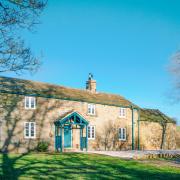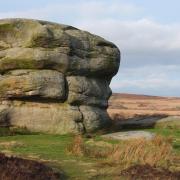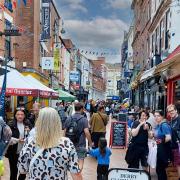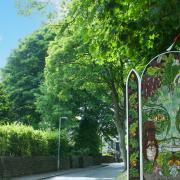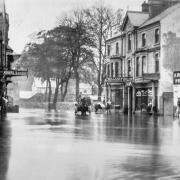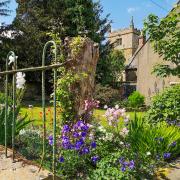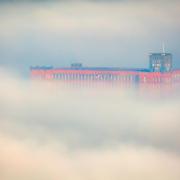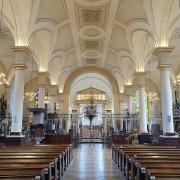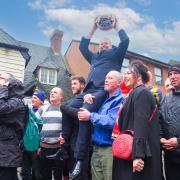The playwright Alan Bennett has praised Frank Matcham, the designer of Buxton Opera House, as ‘undoubtedly the UK’s greatest theatrical architect’.
Few would argue with this assessment of a man who designed over 90 theatres and refurbished a further 80 playhouses between 1879 and 1913.
It might be thought that no architect could achieve this degree of productivity without making repeated use of a standard design, but this is not the case.
Each of Matcham’s theatres are unique in architectural style. Remarkable individuality also applies to their magnificent décor. Styles range from Oriental and Renaissance to Rococo and Baroque.
Given the number of projects Matcham was carrying out at any given time, it is surprising to find that he could always be relied upon to complete a contract in the period specified by those who had hired him. The architect is described by his biographer Brian Walker as ‘a man of remarkable vigour’.
When John Willoughby, the secretary of the Buxton Pavilion Gardens Company, decided to ask Matcham to design a new theatre for the Derbyshire spa, he had no hesitation in using the architect, even though he was engaged at that time with the design of the Empire Palace at Hackney and the new Theatre Royal at Newcastle, as well as finalising plans for a new theatre in Glasgow.

An Edwardian addition
Buxton’s exquisite new Opera House opened in 1903, with its twin miniature domes, decorative entrance canopy and two balustrades being distinguishing external features of this fine Edwardian addition to the Pavilion Gardens complex, a large glass and iron pleasure palace which had been constructed in the Victorian era.
The first production in the new theatre, commissioned by John Willoughby, was Mrs Willoughby’s Kiss, a choice of title which raised a few eyebrows.
All the people who came to see the play were delighted to find they had an uninterrupted view of the stage, because Matcham had replaced the old method of supporting balconies with intrusive pillars by the clever use of hidden cantilevers.
Décor was just as important to the architect as structural considerations. Whilst the audience waited for the play to begin, they were mesmerised by the fabulous ceiling of the auditorium.
The roof, a restrained riot of decoration in blue, gold and cream, is in the shape of an oval dome divided into six panels representing music, painting, poetry, literature, dancing and comedy.
Now beautifully restored, this wonderful ceiling is still hypnotising Buxton’s theatre-goers.
Another delightful decorative element is a sculptured cherub who perches cheekily above a caryatid on the right of the proscenium arch – he holds a real tambourine!

The coming of the ‘talkies’
Early audiences were treated to plays by touring Shakespeare companies, productions of West End successes, ballets and comedies.
In 1927, the theatre was converted for cinema use. Silent films were shown until the building was wired for sound in 1932, allowing the ‘talkies’ to take over. Although the Opera House became increasingly popular as a cinema venue, it continued to present plays and even staged, with the help of the Old Vic, a number of theatre festivals.
After World War II, the theatre operated primarily as a cinema. During this period, the fabric of the building suffered from neglect. Ros McCoola, the author of Theatre in the Hills, painted a gloomy picture of ‘paint peeling, the roof deteriorating, rain pouring in and timbers beginning to rot’.

The launch of a new Festival
The theatre closed in 1976, accompanied by fears that it would never re-open. However, thanks to a vigorous campaign to save this Edwardian gem, funds were found to restore the building, which re-opened in 1979 with the launch of a new festival.
The Opera house now hosts 450 performances per year, including dance, comedy, children’s shows, drama, musical concerts, pantomimes and opera.
Despite various financial crises, the annual festival, now called the Buxton International Festival, continues to bring acclaimed singers, musicians and speakers to the town for two and a half joyful weeks in July.
Although various venues are used for performances and talks, including Fringe productions, the Opera House remains the focal point of the festival and the Gilbert and Sullivan Festival that follows it.
An article in the Financial Times Magazine in 2001 said: ‘European opera houses designed by the Viennese architectural practice of Fellner and Helmer represent a near-ideal marriage of size, acoustic and decorative beauty. Their British equivalents are those designed by Frank Matcham – the best of all being the Buxton Opera House.’

Whilst you are there
Lots of people who come to Buxton in July will have been drawn to the famous Derbyshire spa by the Buxton International Festival.
Many of those visitors will want to find time between the various events to make trips into the stunning countryside on the doorstep of the town.
Indeed, the geographical location of Buxton is one of the reasons why it is such an attractive place in which to hold a festival. Local beauty spots include:

The Goyt Valley
A left turn at the summit of Long Hill (the A5004), a few miles northwest of Buxton, gives access to the Goyt Valley.
The construction of two reservoirs, Fernilee and Errwood, changed the landscape of the valley without destroying its beauty – even enhancing it in the eyes of many people.
Wonderful walking trails in the hills surrounding the lakes include a path that leads to the romantic ruins of Errwood Hall, the former residence of the Grimshawes, who lived there from 1840 to 1932.

Mam Tor
Mam Tor, known as the ‘Shivering Mountain’, is located at the summit of the ‘Great Ridge’, which divides the Vale of Edale from the Hope Valley.
The vista over the Vale of Edale looks towards the foothills of Kinder Scout, the highest hill in the Peak District, where the Pennine Way begins its 268-mile journey to Scotland.
The road descending from Mam Tor to the Hope Valley and the show caves of Castleton runs through Winnats Pass, a spectacular ravine flanked by limestone pinnacles.

Miniature Mountains
A journey of three miles along the Buxton to Ashbourne road (the A515) leads to the High Peak Bookstore and Café, a treasure house of 40,000 books at bargain prices and a venue where great homemade food can be enjoyed.
Just a couple of miles to the south, there is a remarkable Lilliputian landscape of miniature mountains featuring two prominent limestone peaks, Parkhouse Hill and Chrome Hill, each of which has a dramatic profile resembling a dragon’s back.




